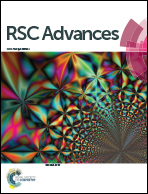Antibacterial properties of main-chain cationic polymers prepared through amine–epoxy ‘Click’ polymerization†
Abstract
Poly(β-hydroxyl amine)s are prepared through an amine–epoxy ‘click’ polymerization process in water under ambient conditions. These materials could be subjected to a post-polymerization protonation/alkylation reaction at the nitrogen atom to yield quaternary ammonium salts in the polymer backbone. The antimicrobial activities indicated that polymers carrying butyl chains at the nitrogen atom are effective towards Escherichia coli (E. coli) and Staphylococcus aureus (S. aureus), as only 10–20 μg mL−1 polymer concentrations are required to inhibit the bacterial growth by >90%. One of the candidates was also found to be effective towards Mycobacterium smegmatis (M. smegmatis) – a model organism to develop drugs against rapidly spreading tuberculosis (TB) infections. The hemolysis assay indicated that a majority of antimicrobial agents did not disrupt red blood cell membranes. The mechanistic studies suggested that cell wall disruption by the cationic polymers was the likely cause of bacterial death.



 Please wait while we load your content...
Please wait while we load your content...